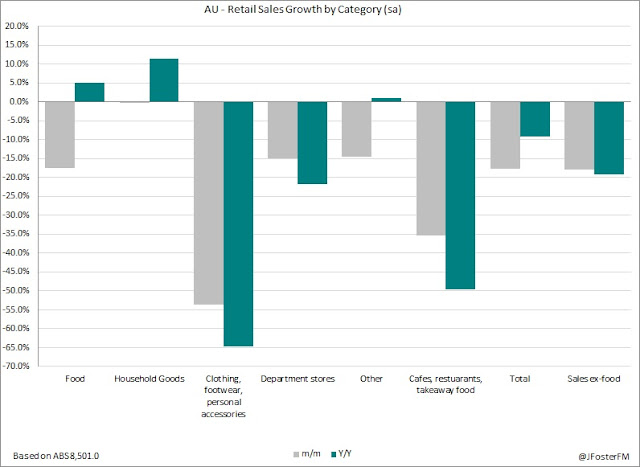Retail Sales — April | By the numbers
- Nominal retail spending rolled over and then some in April falling by 17.7% to $24.791bn (expected -17.9%) as March's initially reported 10.1% surge was revised down to an 8.5% increase. The annual pace of turnover growth swung from 10.1% to -9.2%.
Retail Sales — April | The details
The full scale of the effect of social distancing and the national lockdown came through in today's report as retail spending collapsed by its most on record in April falling by 17.7% to be down by 9.2% over the year — the first time the annual rate has gone negative in the history of the series that goes back to the early 1980s. Retail spending lifted very strongly in March (+8.5%), its strongest monthly rise on record in fact, amid preparations for the lockdown.
The breakdown across the categories showed that only a few areas in household goods (-0.1%m/m) were spared, with hardware, building and gardening supplies rising by 6.6%. The household goods category is strongly higher over the year (11.4%) boosted by spending to facilitate working from home. Basic food mostly reversed its surge from March (24.1%) with a 17.4% fall in April, as did pharmaceuticals (-28.3% from 22.3%). Discretionary spending collapsed, either because the shops were closed or people were not prepared to go out. Clothing and footwear sales fell by nearly 54% in the month and spending at department stores plunged by around 15%
As spending at brick and mortar stores plunged, online retail turnover naturally surged to record highs. In April, online platforms are estimated by the ABS to have accounted for 11.1% of all retail spending. The Bureau's detailed analysis found that an estimated 4.1% of national food sales occurred online in April, while the proportion of non-food sales completed online accelerated from 13.0% to 20.5%.
State details were unsurprisingly heavily negative over the month. In percentage terms, the largest swing occurred in Victoria where spending fell by 21.1% after rising by 7.7% in March. In the other states, New South Wales was down 17.5%mth after an 8.0% rise in March, while Queensland fell 15.7% (from 8.9%), South Australia -14.6% (from 9.4%), Western Australia -16.8% (from 9.9%) and Tasmania -17.5% (from 8.9%).
The full scale of the effect of social distancing and the national lockdown came through in today's report as retail spending collapsed by its most on record in April falling by 17.7% to be down by 9.2% over the year — the first time the annual rate has gone negative in the history of the series that goes back to the early 1980s. Retail spending lifted very strongly in March (+8.5%), its strongest monthly rise on record in fact, amid preparations for the lockdown.
The breakdown across the categories showed that only a few areas in household goods (-0.1%m/m) were spared, with hardware, building and gardening supplies rising by 6.6%. The household goods category is strongly higher over the year (11.4%) boosted by spending to facilitate working from home. Basic food mostly reversed its surge from March (24.1%) with a 17.4% fall in April, as did pharmaceuticals (-28.3% from 22.3%). Discretionary spending collapsed, either because the shops were closed or people were not prepared to go out. Clothing and footwear sales fell by nearly 54% in the month and spending at department stores plunged by around 15%
Retail Sales — April | Insights





